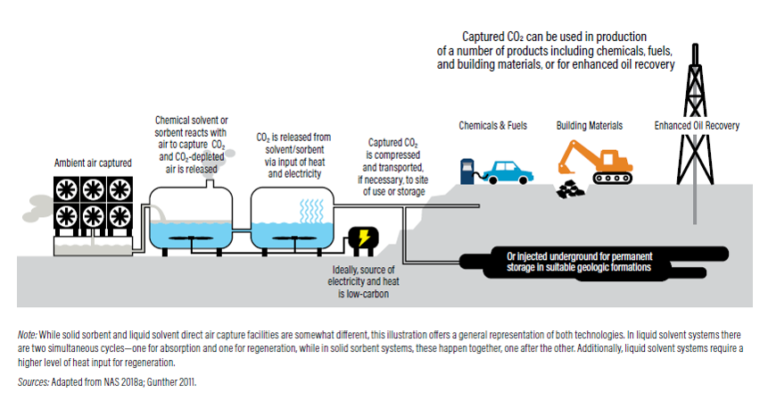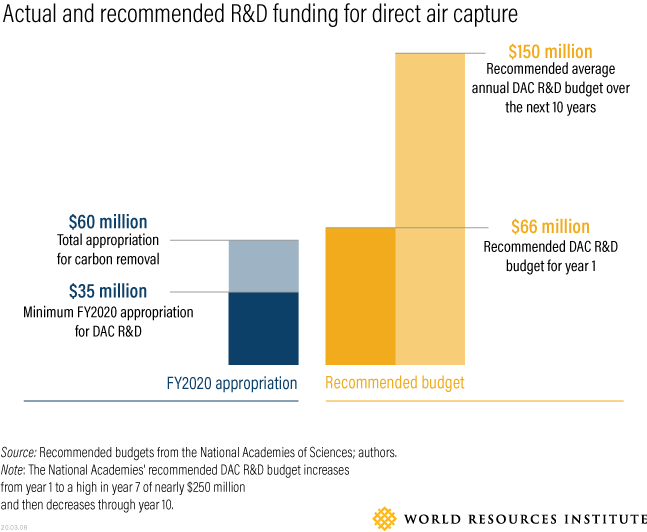Congress recently approved at least $35 million for research and development of direct air capture technology and $60 million overall for research into carbon dioxide removal technologies. This is the first time direct air capture — a type of technology that pulls greenhouse gases out of the atmosphere for storage elsewhere — has received this level of dedicated federal R&D funding in the US.
It’s an important step in the right direction given that most scenario models for how we can avoid the worst impacts of climate change require removing lots of carbon from the air. Recent research shows that direct air capture could plausibly remove nearly one and a half billion tons of carbon dioxide per year by 2050 — equivalent to taking around 300 million cars off the road for a year — if the technology can deploy as quickly as solar PV has and if we start in the next few years. As is the case with all carbon removal approaches, every effort must be made to decarbonize the economy, and carbon removal must complement, not substitute for, emission reductions.
The key to that growth? More public investment is needed now.
Why Direct Air Capture?
Direct air capture is the process of chemically scrubbing carbon dioxide directly from the air. Captured carbon dioxide must then be stored underground or used in long-lived products to result in permanent storage.
It is one of many carbon removal approaches; others range from planting trees to accelerating the weathering of certain rock types. It has gained a lot of attention in recent years in large part because it has no obvious upper bound to its technical potential, can be sited nearly anywhere and requires less land than other proposed approaches like bioenergy with carbon capture and storage.
Because of these characteristics, direct air capture complements natural carbon capture. Natural pathways have significant near-term carbon removal opportunity, but their potential will level off in a few decades. Tree planting, for example, is constrained by land availability and must not interfere with food production, leaving a finite amount of space where trees could be added. Along with other natural pathways, it is readily deployable and should be scaled up now.
At the same time, greater investment is needed in technological approaches like direct air capture that require development and testing before they can be deployed at large scale.
Investing in Innovation
Despite the significant potential direct air capture presents, the technology remains underdeveloped. While some private investment is already going toward existing direct air capture systems — including to the three companies that operate pilot plants today — that investment will be used to optimize existing technologies. Federal investment in basic research and development is also needed in order to identify entirely new systems and materials. Moreover, deployment experience will be needed to drive down costs of all technologies, which will only happen with a public incentive, for example through expansion of the 45Q tax credit. Experience through continued pilot testing could help bring costs of today’s technology down to around $100 per ton of carbon dioxide.
Related Articles: On Extinction, Food, Climate and Inequality | Interview With Azzedine Downes
This year Congress dipped its toes into that water, but it’s time to jump in. The National Academies of Sciences outlined a research and development agenda that would require public investment of $150 million per year on average over the next decade. This would be paired with an average of $483 million per year for supportive tax credits to put us on track to reach the billion-ton scale by mid-century. In comparison, 2018 tax expenditures supporting fossil fuels were a little over $3 billion.
One of the challenges this R&D could address is direct air capture’s energy intensity. Current direct air capture systems require significant input of energy (both heat and electricity) and this energy must be supplied by a low-carbon source for the whole process to be net negative. Scaling up direct air capture to a level where it can capture one billion tons of carbon dioxide per year by mid-century would require 10% of current U.S. energy consumption.
But even with current levels of funding, we have seen notable innovation in concepts for direct air capture technology in just the past few years. For example, researchers at MIT recently developed a specialized battery that captures carbon dioxide as it charges and releases it in a concentrated form for use or storage. Heliogen developed a system that concentrates solar power to very high heat levels. Both could reduce the energy input needed for current direct air capture systems — one of the technology’s main drawbacks.
Another way to get energy: Heat and electricity that are not currently being used. Direct air capture has the flexibility to be sited most anywhere, so could be built near locations where renewable energy isn’t being fed into the grid, for example. Research is also under way to map sources of waste heat — including thermal energy from flared natural gas, or geothermal or nuclear power plants — that could also power direct air capture plants. These sources aren’t big enough to power all the direct air capture we might need but could power it in the near term.
It is quite possible that the types of direct air capture technologies that are brought to scale in coming decades will be completely different from the systems in operation today, and basic research investment is needed to help identify those promising concepts and accelerate innovation.
Direct air capture presents significant technical potential and warrants increased investment. Federal investment could fund basic research to develop and pilot test new concepts. It could also bolster private sector deployment experience, with amendments to the 45Q tax credit, like pushing back the sunset date and increasing the credit value (which currently pays $50 per ton of carbon dioxide stored and $35 per ton of carbon dioxide used for “beneficial use” or enhanced oil recovery).
It is critical to ramp up investment now, so these technologies are ready for wider deployment when they will be needed most.
—
About the Author: Katie Lebling is a Research Analyst II in WRI’s Climate Program where she works on research and analysis of technological carbon removal approaches.
Editor’s Note: The opinions expressed here by Impakter.com columnists are their own, not those of Impakter.com — In the Featured Photo: The US Capitol, where Congress just authorized investment in carbon removal. — Featured Photo Credit: Lara Eakins













